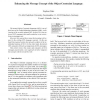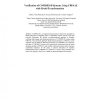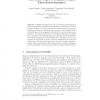115 search results - page 8 / 23 » Formalizing organizational constraints: a semantic approach |
AAAI
2008
13 years 11 months ago
2008
Action languages allow to formally represent and reason about actions in a highly declarative manner. In recent work, revision and management of conflicts for domain descriptions ...
CIA
2004
Springer
14 years 2 months ago
2004
Springer
Given a specification of communication rules in a multiagent system (in the form of protocols, ACL semantics, etc.), the question of how to design appropriate agents that can oper...
SEKE
2004
Springer
14 years 1 months ago
2004
Springer
The textual Object Constraint Language (OCL) is an official part of the Unified Modeling Language (UML). A new concept in the recently adopted OCL version 2.0 is the notion of O...
RTCSA
2008
IEEE
14 years 3 months ago
2008
IEEE
COMDES-II is a component-based software framework intended for Model Integrated Computing (MIC) of embedded control systems with hard real-time constraints. We present a transforma...
DAGSTUHL
2003
13 years 10 months ago
2003
STAIRS is an approach to the compositional development of sequence diagrams supporting the specification of mandatory as well as potential behavior. In order to express the necess...



